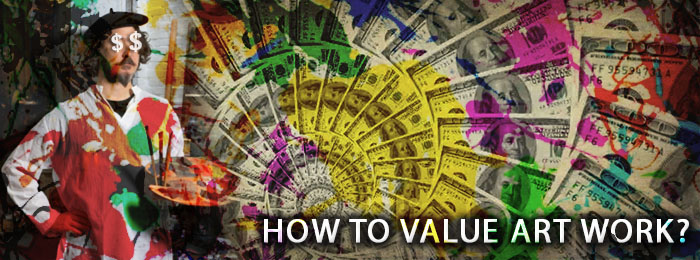ViNNi KiNiKi Art Store
How to value art? An artists perspective

How does one attach a monetary value to art?
How to value art? This is something I struggle with as an artist, both in regards to my own art as much as the price tags that other artists and galleries apply to theirs. The art world is crazy in terms of what makes an art piece valuable (and in many cases ludicrously expensive) and conversely what devalues artwork to make it worthless (or should I say priceless?).
I think there are a number of things that influence the price of a given art piece, I’m not saying this is what I agree with, I’m saying these are things that I have noted during my career as an artist, if you think I am wrong or want to add something to the discussion I welcome you to comment below. I will come back to revise this article in the future and my resolve will be strengthened through discussion…
These are the main factors which i believe influence the value of art…
>> Fame
Simply speaking the more famous and recognized the artist is the more valuable the art work. The common anecdote; no artist’s work is valuable until the artist is famous, no artist is famous until the artist is dead, and there is a lot of truth in that supposition but it’s certainly not an accurate way of determining the value of art work. Although it’s stands to reason an artist with a large following who dies cannot create any more art, therefore increasing the cost of all previous art pieces created by said artist.
>> Mass Appeal?
This brings me on the next topic. Is the artwork of multiple editions? Stencil art and art prints are easily reproduced. Something painted on canvas is usually a one-of and therefore by design a much rarer and exotic object to own. However I have seen time and time again struggling and unrecognized artists having to sell their canvas art for far less than most established artists sell an art print for. But the rule does still apply, the smaller the number of limited editions the higher the value of the editions. So there is something about the rule of rarity that does apply.
>> Exhibition Context
Some of the most brilliant art in terms of artisan skill I have seen has been painted on street. Graffiti, stencils, whatever technique it is, large scale street art painting is one of the most talented forms of art there is. When you think about the level of detail in the art and then relate it to how many things were going against the artist during the creation (lack of light, cold, cops, hanging upside down? Death!) – it is remarkable the graffiti piece exists in the first instance! Mostly this artwork is worthless (or better put ‘priceless’) because it simply cannot be sold!
Conversely some of the basic, primitive and crudely constructed art seen in high society art galleries is sold for crazy amounts of money. Before you think I’m spouting under educated or anarchist sentiments, please argue me how much artisan effort went into taking a shit in a can and then having the big gallery players such as the Tate purchase it for exhibition? This proves the point that the value of art is somewhat dependent on its end display context and purpose. Art that relies less on artisan skill and saves face through a torrent of intellectual masking and high-brow dogma tends to sell for a lot, conversely some high skilled art created with no explanation doesn’t reach quite as high a price tag.
One most also note that any art piece sold through an art gallery context is normally considerably more expensive than what the artist would otherwise demand for the art. Most art galleries take a commission for sale of art, most artist aren’t happy with getting any less than what they think it’s worth, so usually a large sum is added onto the price the artist initially had in mind. Having said that there are many successful artists who exist despite not having any gallery representation or agent.
>> Construction & Materials:
Unless your canvas or sculpture piece relies heavily on the aforementioned dogmas and explanations it is highly unlikely to be worth much unless it’s solidly constructed. Usually when something is designed to last a certain amount of time (eg an exhibition) it usually gets termed “installation art” rather than sculpture, here the rules differ. The art is arguably poorly constructed but amazingly this doesn’t diminish the value, quite the contrary! Tracey Emin wouldn’t have had the problem of people wrecking her bed installation art piece if it was made solidly and Damien Hirst wouldn’t have had his art trashed by a cleaner… This are not perhaps the best examples to give as I realise the art work relies partially on the materials used to make it to give the context and meaning of the art.
The cost of materials used is usually a strong indicator of what the eventual value or the art will be. It’s practically a given that an art piece will not be sold for a value less than the cost of the raw materials of the art. However with every artist having stock piles of unsold art in their studios sometimes cutting losses and selling art for something rather than nothing does happen.
Conversely some art created which uses raw materials which are cheap or even free are sold for millions, many of you will know about a certain pile of bricks exhibited in the Tate that was sold for way more than value of materials, less attention to details was applied to the art piece itself than a bricklayer building a wall! So, material cost is not something to completely base the determined cost of the given art piece.
>> Ingenuity / Freshness / Uniqueness
How unique is the artists produce? How easily can it be produced by someone else?
>> Collectability
Is the art part of a series? Is the artist’s work highly collectible? Some artists make installation art which may be temporary or created for purposes of exhibitions, not collectible. Other artists create prints and multiple editions, there work tends to be more easily accessible to private art collectors.
>> Condition
This doesn’t apply to canvas art as much as it would to say installation or sculptural art work, but basically if the canvas has (unintentional) holes, tears, scratches, unwanted markings, rot etc… It’s general seen as being heavily devalued. However some art is designed in a way that incorporates these ‘defects’
>> Authenticity – A bit of a no brainer, but for the people whose purchases are inspired by brand value ( in this case talking about the ‘brand’ namely the artist) the art work is not going to be seen at all valuable or worth much if it nothing more than a knock off fake posing as genuine artist’s work.
How to value art – a conclusion
In closing I will say, there have been times where it’s taken me months of deliberation and planning even before doing any actual painting on a canvas, some art take weeks or even months to finish. In some cases the art doesn’t get finished at all and might get relegated to artist’s studio stock pile only to be completed many years down the line or perhaps just painted over with new layers.
Conversely some art I create seems to pour out of me onto the canvases, some canvas pieces get started with no intention of finishing them, but somehow regardless, are completed a mere few hours later. One piece in particular is a canvas piece I entitled aliens invade which literally took around 2-3 hours to complete! You can read about the process here
Does the art work only become valuable once it leaves the studio or point of creation? Certainly I cannot buy it from myself… well I suppose I could, but I’m not conceptual enough to pull it of ;).
So what else can influence the price and value of art? In addition to the above let me know if you can think of others! Leave your comments bellow.
Vinni Kiniki 2014





